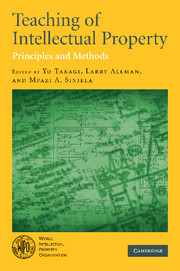Book contents
- Frontmatter
- Contents
- Notes on contributors
- List of abbreviations
- Table of figures
- Foreword
- 1 Recent trends and challenges in teaching intellectual property
- 2 Teaching patents
- 3 Teaching copyright and related rights
- 4 Teaching trademark law
- 5 Teaching industrial design law
- 6 Teaching intellectual property, unfair competition and anti-trust law
- 7 Teaching the economics of intellectual property rights in the global economy
- 8 Teaching intellectual property in a business school
- 9 Teaching IP practical skills for practitioners and attorneys
- 10 Teaching intellectual property to non-law students
- 11 Using the new technologies in teaching intellectual property (distance learning)
- 12 Teaching current trends and future developments in intellectual property
- Index
3 - Teaching copyright and related rights
Published online by Cambridge University Press: 05 June 2012
- Frontmatter
- Contents
- Notes on contributors
- List of abbreviations
- Table of figures
- Foreword
- 1 Recent trends and challenges in teaching intellectual property
- 2 Teaching patents
- 3 Teaching copyright and related rights
- 4 Teaching trademark law
- 5 Teaching industrial design law
- 6 Teaching intellectual property, unfair competition and anti-trust law
- 7 Teaching the economics of intellectual property rights in the global economy
- 8 Teaching intellectual property in a business school
- 9 Teaching IP practical skills for practitioners and attorneys
- 10 Teaching intellectual property to non-law students
- 11 Using the new technologies in teaching intellectual property (distance learning)
- 12 Teaching current trends and future developments in intellectual property
- Index
Summary
Introduction
Around the middle of the last century, the importance of copyright within both undergraduate and postgraduate courses was relatively modest. In the undergraduate curricula – where it extended, if at all, to intellectual property rights in general, and to copyright, in particular – only a couple of hours were devoted to these rights. As regards copyright, this usually consisted of an outline of the social-political justification of copyright protection, the identification of the applicable national law and international treaties (in general, only the Berne Convention), a listing of moral rights and economic rights along with the exceptions to, and limitations of, the latter rights, a reference to the term of protection, some discussion about copyright contracts and a brief description of the available enforcement measures.
Since that time, there have been accelerating developments in and around the field of copyright. These have included: the recognition of related (or “neighboring”) rights in the Rome Convention and in more national laws; the advent of a number of new technologies for the creation and use of works and objects of related rights; the emergence of widespread piracy as a result of the ever easier and more perfect reproduction technologies; the extension of copyright protection to new categories of works (such as computer programs, databases and videogames); the growing importance of copyright industries for national economies and international trade, reflected, inter alia, in the TRIPS Agreement; and the spectacular success of digital technology and the Internet with a number of challenges for copyright and related rights, leading to the adoption of the WIPO “Internet Treaties” (WIPO Copyright Treaty (WCT) and the WIPO Performers and Phonograms Treaty (WPPT)).
- Type
- Chapter
- Information
- Teaching of Intellectual PropertyPrinciples and Methods, pp. 33 - 62Publisher: Cambridge University PressPrint publication year: 2008
- 2
- Cited by



